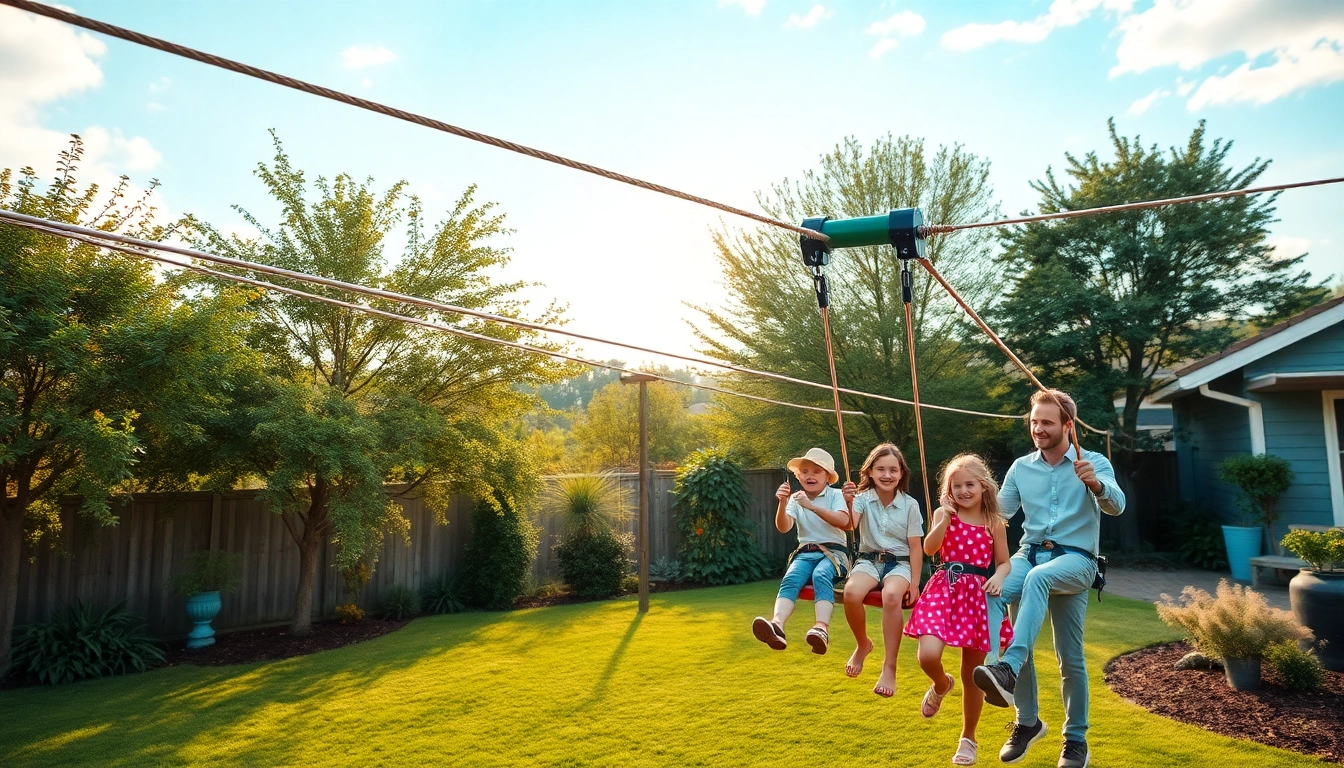Understanding the ZIP WIRE KIT Basics
What is a ZIP WIRE KIT?
A ZIP WIRE KIT is a system that allows individuals to slide along a cable from one point to another, typically suspended above the ground. These kits provide an exhilarating outdoor experience that combines fun with a sense of adventure. They are ideal for both children and adults, promoting interactive play, outdoor exercise, and family bonding. A ZIP WIRE KIT can be installed in various locations, such as backyards, parks, or nature reserves, providing an accessible way for families to engage in adventure without the necessity of a commercial amusement park.
Key Components of a ZIP WIRE KIT
A typical ZIP WIRE KIT consists of several essential components that work together to create a safe and enjoyable experience. Here are the key parts:
- Cable: The primary component, the cable is the line along which the rider travels. It is usually made of steel and has a specific length and weight capacity.
- Trolley: This is the mechanism that rides along the cable and securely carries the user. It typically includes bearings for smooth movement.
- Anchors: These are used to secure the cable at both ends. Proper anchoring is critical for safety and stability.
- Safety Harness: A harness secures the user to the trolley, ensuring they are safely attached during their ride.
- Brake System: Most kits include some form of braking system to slow down the rider towards the end of the zip line.
Types of ZIP WIRE KITS Available
There are various types of ZIP WIRE KITS available, catering to different ages, preferences, and installation environments:
- Backyard ZIP WIRE KITS: Designed for residential settings, these kits can vary in length and weight capacities to suit children and adults alike.
- Commercial ZIP WIRE KITS: Heavier-duty kits suitable for parks and recreational facilities, often built for high traffic and durability.
- Portable ZIP WIRE KITS: Lightweight and designed for easy setup and takedown, these kits can be used in various environments.
- High Adventure ZIP WIRE KITS: Designed for extreme enthusiasts, these kits often feature longer cables and higher weight limits.
Benefits of Installing a ZIP WIRE KIT
Physical Activity and Family Bonding
Installing a ZIP WIRE KIT encourages physical activity among family members. Zip-lining engages muscle groups, improves coordination, and boosts cardiovascular health. It’s a fun way for families to exercise together, promoting healthy habits while creating lasting memories. Experience outdoors with a ZIP WIRE KIT enhances physical fitness while fostering connections as family members cheer each other on.
Enhancing Outdoor Spaces
A ZIP WIRE KIT can transform an ordinary backyard or outdoor area into a vibrant recreation space. This enhancement not only benefits the family using it but can also increase the appeal of the property for visitors and potential buyers. Incorporating a zip line encourages spending more time outdoors, encouraging children and adults alike to disconnect from technology and enjoy fresh air and nature.
Creating Memorable Experiences
Experiences at a ZIP WIRE KIT are exhilarating and memorable. Whether it’s a child’s birthday party, family reunion, or just a regular day, zip-lining provides unique stories and experiences that can be cherished for years. The thrill of soaring through the air creates moments of joy, excitement, and a sense of accomplishment that bonds people together, making these experiences unforgettable.
Choosing the Right ZIP WIRE KIT for Your Needs
Factors to Consider Before Purchase
When selecting a ZIP WIRE KIT, several essential factors should be considered to ensure it meets your specific needs and expectations:
- Age of Users: Ensure the kit is appropriate for the age and weight of the intended users. Some kits are designed specifically for children, while others cater to a broader age range.
- Installation Space: Evaluate the space available for installation, including height requirements and distance between anchor points.
- Weight Capacity: Each kit will have a maximum weight capacity, crucial for safety. Ensure you select a kit that accommodates all potential users.
Size and Weight Capacity
The size of the ZIP WIRE KIT plays a significant role in its functionality. Smaller kits are ideal for children and require less space for installation. Conversely, larger kits designed for adults offer longer rides but need more distance between anchor points. Always check the weight capacity before purchasing to prevent accidents during use. Many kits recommend a maximum weight for safe riding, and some also outline the appropriate age groups to guide in making the right decision.
Safety Features to Look For
Safety should always be the top priority when selecting a ZIP WIRE KIT. Look for kits that come with comprehensive safety features, including:
- Quality Harness: Look for a well-constructed safety harness that fits securely and comfortably.
- Reliable Brake System: Check if the kit has an effective braking system to control speed and safely bring users to a stop.
- Anchor Construction: Sturdy anchors are crucial for safety; they should firmly secure the kit to avoid slippage or failure.
- Clear Instructions: A kit should come with straightforward installation instructions and user guidelines to promote safe usage.
Installation Process for ZIP WIRE KITS
Tools and Materials Required
Install a ZIP WIRE KIT involves several tools and materials. Here’s what you typically need:
- Power drill and drill bits
- Wrenches and screwdrivers
- Measuring tape
- Level
- Safety goggles
- ZIP WIRE KIT components (cable, trolley, anchors, etc.)
Step-by-Step Installation Guide
The installation process for a ZIP WIRE KIT can vary, so it’s essential to consult the specific instructions provided. However, here are general steps to guide you:
- Choose the Location: Identify and prepare an area with sufficient space, height, and stable anchor points.
- Secure the Anchors: Install the anchors on both ends of the intended zip line. Ensure they are tightly secured and level.
- Install the Cable: Connect the cable to the installed anchors, ensuring it is taut but not overly tight.
- Attach the Trolley: Fix the trolley to the cable along with the safety harness attached securely.
- Final Inspections: Before use, double-check all connections, installed parts, and ensure the kit is properly set up.
Common Mistakes to Avoid
When installing a ZIP WIRE KIT, several common mistakes can lead to safety hazards or subpar experiences:
- Ignoring the Weight Limit: Ensure not to exceed the specified weight capacity during use.
- Improper Anchoring: Secure anchors need to be firmly installed to prevent any accidents during use.
- Rushing the Installation: Take time to follow all instructions carefully and double-check the setup.
- Underestimating Maintenance: Neglecting the maintenance guidelines can lead to safety issues; routine checks are essential.
Maintaining Your ZIP WIRE KIT for Longevity
Regular Safety Checks and Inspections
It’s essential to conduct regular safety checks on your ZIP WIRE KIT to ensure everything is functioning correctly and safely. This includes:
- Inspecting the cable for signs of wear or damage
- Checking the trolley for smooth movement and any obstructions
- Reviewing anchors for stability and security
- Examining the harness for signs of fraying or wear
Weatherproofing and Care Tips
To prolong the lifespan of your ZIP WIRE KIT, consider the following care tips:
- Weather Protection: If possible, store components indoors when not in use, particularly in extreme weather conditions.
- Regular Cleaning: Periodically clean the cable and trolley to prevent dirt and debris buildup, which can cause wear and tear.
- Inspect After Weather Events: After heavy rain, winds, or storms, check the installation for any potential damage.
When to Replace Components
It is vital to know when to replace parts of your ZIP WIRE KIT to maintain safety. Components that should be replaced include:
- Cable: If the cable shows significant wear, fraying, or rust, replace it immediately.
- Trolley: If the trolley is not rolling smoothly or shows visible damage, it should be replaced.
- Harness: Frayed or damaged harnesses should not be used and must be replaced to ensure safety.



